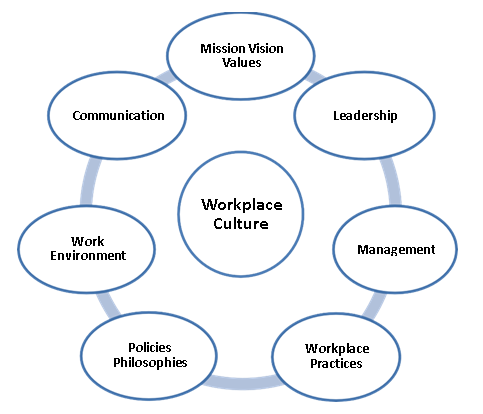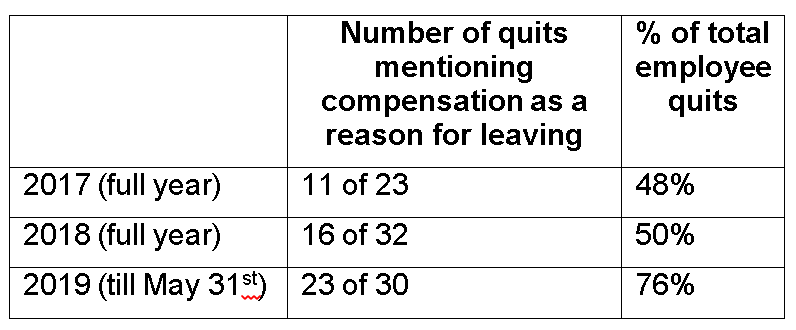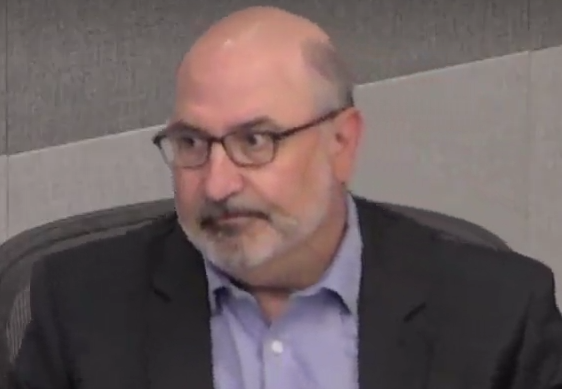 By Pepper Parr
By Pepper Parr
July 19th, 2019
BURLINGTON, ON
Human Resources is responsible for attracting and retaining City employees; staff/labour relations; employee benefits; health and safety; pay research and staff training and development.
This just might hurt a little – it is about what Director of Human Resources Laura Boyd called Enterprise risk – labour market, in a report to Council. We are not paying staff the going rate, a lot of people are quitting and some critical people are retiring. It got a Receive and File Recommendation from Council.

Director of Human Resources Laura Boyd
Boyd points out that with the focus on “the implementation of many strategic initiatives by the Burlington Leadership Team (BLT) through the development of performance measures and completion by dates, thought has to be given to the successful execution of the plan with its goals, resources, and budgets, and we also must consider the staff team who will execute the strategy.”
Management consultant Peter Drucker put the challenge that faces every organization very well when he said: “Culture eats strategy for breakfast.”
What this means is that while targets and performance measurements have been identified, it is workplace culture and focused leadership that will drive the execution of strategy. Culture will either strengthen or undermine our ability to attract and retain quality employees to execute this strategy.
Burlington is now on its fourth City Manager in as many years. The city now has a decidedly different city council that doesn’t subscribe to the approach taken by the Goldring councils.
The retention of employees and what we pay the employees working at city hall is an issue that needs attention.
The purpose of the report Boyd put before council was to review ”those attributes which make up a healthy workplace culture; identify risks to our own culture; and map out the steps required to move forward.”
The corporate culture is an issue. In her report Boyd described culture as:
• The critical organizational element that will attract talent, drive engagement, impact satisfaction and affect performance
• The personality of the business;
• The City’s employment brand;
• The sum of its values, traditions, beliefs, interactions, behaviour and attitudes;
“Simply put – culture is the difference between having a performance driven, highly engaged organization which executes ongoing strategy and an organization where goals are set, targets are generally met, and staff are performing satisfactorily overall.”
Is Burlington meeting the standard? Not if the number of people who have quit is any indicator.
The following seven attributes define those areas that influence a workplace culture.

The seven attributes define those areas that influence a workplace culture.
The following data was provided to Council to assess current workforce strengths and risks with regards to the ability to deliver Council’s priorities.
In 2016 the City conducted its first Culture Survey. While the results are now three years old, the following were the high and low scores at that moment in time:
High scores:
• Planning the work is ongoing and involves everyone in the process to some degree;
• There is an ethical code of conduct that guides our behaviour and tells us right from wrong;
• Teamwork is used to get work done, rather than relying on orders from management
• There is continuous investment in the skills of employees
• Public input directly influences our decisions.
Low scores:
• Leadership has clearly communicated objectives we are trying to accomplish;
• There is a clear and consistent management style, so employees know what to expect;
• There is a clear and consistent culture;
• We continuously track our progress against our stated goals;
• Our people are viewed as an important source of our competitive advantage.
“When the results were further analyzed, it became apparent that communication within the organization diminishes between hierarchical levels.
Specifically, between the Burlington Leadership Team and the Supervisors/Manager level and then between the Supervisors/Managers level and their direct reports.”
If that is Burlington’s situation – no wonder there is trouble in paradise.
In response to the 2016 survey four employee teams were set up to identify and execute projects/programs to improve our results. Specifically, the teams organized themselves around the following themes and have been developing and implementing programs to address our survey results and improve our culture:
• Innovation
• Staff Investment
• Organization Values
• Communication
“Turnover is a simple retention measure.” Would that it were so and that simple.
Boyd’s report said: Over the past decade voluntary turnover at city hall has remained consistent between 4.2% to 5.7%. Voluntary turnover includes those staff who have quit or retired to date.
From the results below, Boyd reports that “we are trending to a much higher voluntary turnover in 2019 – closer to 10%.

Boyd makes the critical point: “It is important to know why we are experiencing higher turnover. When voluntary turnover for the past two and a half years was reviewed, compensation came out clearly as the most significant factor.”
Number of quits mentioning compensation as a reason for leaving % of total employee quits

Examples of other reasons provided for employees leaving varied and include promotions, job closer to home, position not the right fit and supervision to name a few.
Burlington has found that there are position difficult to fill.
A review was completed of the positions which were advertised externally in the marketplace from the perspective of how difficult it was to fill these roles.

Difficult to fill positions can occur for several reasons including compensation, not attracting qualified candidates, and being turned down by first candidates and having to offer to second or third choices.
As an example Boyd pointed to the Legal Department, the position of Solicitor was advertised, our offer was turned down, even after considerable negotiation, and we have now employed an outside agency to assist in sourcing appropriate candidates.
A forecasting report has been obtained from OMERS to assist the city in identifying who can retire with an unreduced pension up to 2023. Currently there are 185 employees who can retire with an unreduced pension by 2023. This represents 20% of the city’s full-time workforce.
Of the 185 people who can retire, 36% are people leaders while 64% are individual contributors.
This comes close to gutting the leadership level which some people feel is the best thing that can happen to the city.
Following is a yearly breakdown of the retirement outlook:

“A non-union compensation analysis was conducted by Mercer – the results were made Confidential.
Most private companies align themselves with a market position of the 50th percentile – however in the highly competitive GTA, public sector employers align with the 60th to 75th percentile to compete for employee resources.
“The City’s current Council approved market position is the 65th percentile however our recently surveyed actual job rates are now aligned with the 50th percentile.
“To realign with the 65th percentile, job rates will have to be increased by approximately 3% to 8%.”
By rates Boyd mean salary rates and while the percentage may seem small it will have a huge impact on the budget. And that 8% will drift up to 10% – maybe more.
“Our market competitiveness varies across the salary grades and this is likely an indication of challenges with our job evaluation system, which was developed in the 1980’s, not being reflective of current workplace requirements and expectations.
There are processes and programs in the works. Boyd reports that the ‘Following are examples of projects and initiatives that are either in process or that have been implemented which positively impact our culture:
Corporate Culture Area Examples of Completed and In-Progress Culture Activities
Leadership • Mohawk Future Ready Leadership Program.
• DeGroote Leadership Development Program
• Launch of Succession Management Program
• Review of the role and the function of BLT
• Introduction of Leadership Competencies
Management • Introduction of Mobile Workforce guidelines
• Discontinuation of performance appraisal form and the introduction of Coaching and People Leader Training for the setting and management of performance expectations
Workplace Practices • Introduction of BRAVOS Awards
• Realignment of Performance Excellence Program and Service Awards
• Development and launch of Organization Values.
• Restating the Dress Code policy to the more flexible “Dress for Your Day” guidelines.
• Staff BBQ and holiday gathering

There was a time when staff at city hall had some fun. This photograph is the crew from the Clerk’s department taking part in a United Way fundraising effort.
Communication
• The development and communication of Council’s four-year work plan identifying action, projects and initiatives with measurements.
The report concludes with the following:
“The City of Burlington has been and will continue to be a great employer however, we are exposed to considerable human resource risks.”
It is self-serving statements like the above that frighten people. The truth is there are some very serious issues that need immediate attention. Boyd is correct when she says:
“To deliver council’s work plan and to build upon our employment brand, we need to put a conscious effort into strengthening our workplace culture. We are experiencing workforce pressures not previously felt, pressures which will require targeted action to be able to retain engaged and skilled staff and to compete in the marketplace for qualified staff.
“We need to deliver on Council’s priorities through strategic focus and execution. Our Enterprise Risk Registry has identified our workforce as the number one risk facing this organization and the data outlined above supports this position on the registry.
“We are now starting to feel significant attraction and retention pressures which will impact our culture and therefore our ability and internal capacity to deliver the work plan. To address these pressures the following next steps have been identified:

City manager Tim Commisso has his hands full keeping council out of the reserve fund cookie jar; developing a culture that is real and will hold
“Priorities and accountability for delivery of Council’s work plan have been clearly identified and assigned to members of BLT. A review of the corporate structure, one which will assist the City Manager to strategically transition the organization into a more flexible twenty-first century organization, will occur over the next few months.
“In addition, the City Manager, in keeping with the direction approved by Council during the 2019 budget, is completing the realignment of the City Manager’s Office to address the overall strategic management capability of the organization. The goal of this review is to ensure our structure is aligned to retain highly skilled staff and to attract new talent entering the workforce. In support of this goal, a review of the role of the Burlington Leadership Team is also underway.”

A BBQ for staff – the sale of the burgers was part of a United Way fundraising effort.
A second culture survey will be done in the Fall of 2019. A comparison of 2016 to 2019 results will assist us in determining where there are further gaps so that we can target additional efforts in those areas.
There is to be a Diversity and Inclusivity strategy and implementation plan for execution over Council’s term.
“Expanding the recruitment channels, ensuring the culture within the workplace is open, welcoming to all and is reflective of our community will strengthen the City as an employer now and well into the future.”
The problems with hiring is that the municipal world has a culture and a set of conditions that are hugely different from the private sector. Municipalities end up stealing each other’s staff.
Boyd adds that “ this report has provided some information about the city’s current competitiveness to the marketplace, a follow-up report with detailed compensation system recommendations and potential cost impacts will be brought to Council in the early fall. The following items will need to be considered and approved by council in this follow-up report:
• The City’s competitive market position;
• Appropriate municipal comparators; and
• Development and implementation of a new job evaluation system.
In the meantime, the leadership team will be considering where temporary market premiums are required to retain highly skilled or at-risk employees and implementing these premiums as appropriate.
Boyd concludes that: “It is important to appropriately align the City’s resources, both budgets and staff, to ensure the successful execution of Council’s work plan. This report outlines the human resource and workforce pressures we are currently experiencing which puts at risk our ability to successfully implement Council’s work plan.
Put colloquially – Burlington isn’t able to put a solid team on the field – and we are all paying the price for past in-actions.


















As a former City employee, there are a lot of issues at play that make for a poor work culture. For years the City has spread employees too thin in many different departments- staff are expected to run extra lean in order to meet objectives and keep taxes low…however the expectations of residents and what they expect to get in levels of service can’t be provided with current staffing levels without having employees either burn out or leave. I lost countless hours in “flex” time, extra hours needed to get the job done but were never compensated for. Lack of recognition is another issue…we’d put hours of time into different initiatives (above and beyond regular duties) and never receive a thank-you or any form of recognition for efforts, yet these initiatives made leadership and council look good. We used ancient software systems and computers (desktops in 2018!) that were frustrating to use and made it virtually impossible to do work from home – which we needed to do when we got calls or emergencies after hours. Having to park almost a kilometre away from the office and have to pay for it in the form of a taxable benefit. Yes it may have added extra exercise into the day, but the sidewalks in the winter made it treacherous and just added extra time onto an already long day. The culture survey was a joke, it hardly touched on any employee satisfaction questions. Dave was right above, the salary is much higher in our surrounding municipalities (approximately $10-15k difference in my position in Hamilton and Oakville) but salary is only a part of the issue. I enjoyed my coworkers and the work, however for my own mental health (we did have good benefits and training) it was time to move on. Especially when you have a new mayor who has outwardly threatened staff jobs, imagine how happy you’d be coming to work with that going on, knowing that no matter how you justify what you do, you have a Mayor that has made you look terrible to residents. I’m currently in the private sector, closer to home, with more money, less hours and a free parking spot. Thank-you for listening.
I was one of those employees who left the City in the last two years! And I can say that yes compensation was a driving factor for me (the City underpays compared to all other surrounding cities) and so was the lack of leadership at the top. I didn’t care to put up with it, as for Laura, no one knows about her – I didn’t! The HR Department there is the “Dept hiding in the shadows”.
Penny you make a great point but residents and counsel need to look in the mirror to understand why we can’t attract top quality staff. Imagine working in the planning department of the City of Burlington for the past 3 years. Staff were asked to put countless hours of work into a new official plan, meet with residents and receive feedback, use their professional experience and education in planning, reference best planning practices from all over the world, strike a balance and create a new plan. After years of work the plan was finally put into place. It was a badly needed update to an old plan that was challenged and failed at the OMB several times because it did not meet updated targets / goals from the province. Then…. we elected a new counsel, and the plan was essentially thrown in the garbage. I would probably quit too. People with this level of experience and expertise are in high demand. Why would they work for a city that is fighting with itself and getting nothing accomplished? Why would they work for a city that has completely politicized development and does not respect their experience and education in planning? We have all become armchair city planners, thats not a great environment to work in.
Please be careful about putting too much stock in reports that highlight compensation as the major reason people are leaving. From first-hand experience I can tell you that compensation is often a fall back position people use to explain their decision. What is often the primary cause is supervision and bad management. Unless the study was conducted by a third party I would treat the findings with considerable suspicion.
With Mayor Chaos at the Helm and all these folks jumping ship. Or her my way or the highway approach. Some employees are having trouble being forced to ignore Provincial polices which they have an obligation to follow. Instead being forced to follow The Mayors misguided policies inconstant with Provincial policies. Reminds me of the movie Titanic watching people jumping from the ship before it goes down.
For some reason I’m reminded of the movie Fatal Attraction.
Burlington is now on its fourth City Manager in as many years.
Chaos starts at the top.
Quality employees don’t like chaos.
Quality employees can find other jobs easily.
Why is anyone surprised that there is a high turnover this year.
Look at what was a low score in 2016.
• There is a clear and consistent management style, so employees know what to expect;
The turnover at the top makes it hard to attract quality employees.
This article conflates higher compensation with better retention and morale which is not always the case.
First, most employees don’t typically leave for higher compensation. Studies have repeatedly shown that the number one reason precipitating a job change is poor management or supervision. Given the highly confrontational leadership style exhibited by the former City Manager, and the emotionally charged state of municipal politics in Burlington, it is probably not altogether surprising that some have chosen to leave. The number two reason is usually lack of challenging work.
Second, relying upon a three year old Culture Study as a reliable gauge of employee engagement is neither accurate nor timely. A lot can and probably has changed since that survey was conducted, and if there have been as many retirements and leaves as this article suggests then the survey population has likely changed also. By my count, it is 151 leaves between 2017 and now (i.e. quits + retirements).
Third, just because an employer pays at the 65th, or 75%, or even the 90th percentile, is no assurance that employees will stay. No amount of higher remuneration can compensate for bad leadership or lack of career challenge.
Here’s what the article doesn’t reference. If 185 people can retire over the next few years, then the City should use this as an opportunity to conduct a substantive organizational review of its operations…not later, but now! If 64% of those positions are individual contributors, then it should examine and explore ways in which these positions can be combined, work automated, duplication eliminated, and remaining jobs enriched. Too often in organizations the tendency is to automatically job post or advertise positions once they become vacant with scarcely a thought given to whether the position is actually needed, or if the work can be completed differently. If there are bright, talented young people with the potential to move into more challenging positions then they should be identifed, mentored and groomed to assume higher positions, and use retiring employees to provide that tutelage.
Short-term fixes like BBQ’s, tweaking the dress code or juicing the compensation plan are simply that: short-term fixes with superficial appeal. If we want impactful change then the Mayor, Council and the City Manager need to devise a plan to get it.
Thank you Stephen for your comment that quite obviously comes from both considerable expertise and a depth of experience. It touches on all the points that I was intending to address and far better than I could do so I won’t repeat. I was particularly pleased that you addressed the three year old employee survey. Much too great an interval and lends itself to the rather dismissive attitude that ‘that was then, different Council, somewhat different management team etc.’ And the employee survey is certainly not the only indicator of organizational culture, although it is an important one. On the provincial level, employee surveys are conducted every year and the corrective actions needed then featured in the responsible manager’s performance agreement. It becomes a key component of the performance review. It is also a significant component of the whole succession planning and talent management programs. The article states that “A forecasting report has been obtained from OMERS to assist the city in identifying who can retire with an unreduced pension up to 2023. Currently there are 185 employees who can retire with an unreduced pension by 2023. This represents 20% of the city’s full-time workforce.” If such a report is not part of the ongoing program responsibilities of the Human Resources area at COB then I am both shocked and appalled. Such an information resource should be absolutely fundamental to the planning, training and succession management responsibilities of HR and should be produced internally then validated against the OMERS data. If this is not the case, then the City has, indeed, a very long way to go.
The concern of attracting and retaining quality employees is an industry wide issue right now in both the private and public sectors. Anything engineering or planning based there is a huge demand in the industry with every company and municipality struggling with the same issues.
Demand far outweighs supply at the moment so salaries are skyrocketing as a readily which is creating a “musical chairs” scenario across the board where people are jumping around to get significant bumps. The problem is that this creates further retention issues with current employees. The 8-10% bumps might keep some people but when private companies offer 20-50% bumps with stock options or bonuses municipalities just cannot compete
Lots of talk about what people are, getting,or not getting, salary wise, but no examples of what those salaries are. Curious.
Could this be the first step in telling residents that targets won’t be met with regard to the Interim Control By-law, the un designating of the downtown mobility hub and perhaps to be working with the Province in moving the Downtown Urban Growth Centre? We have 8 months left on the ICBL and a new Official Plan needs to be completed by 2020.
For a long time residents have questioned the ability of city employees in some departments in keeping up with the job. This report seems to prove residents right.
We should not be blaming developers if staff cannot meet the requirements set out by the province.
If the city cannot attract and retain quality employees it does not bode well for the residents of Burlington.